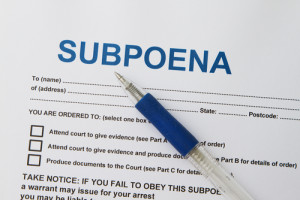eBay Must Disclose User Identities In Response To 512(h) Subpoenas

Photo credit: Close up picture of Subpoena with pen // ShutterStock
eBay moved to quash the subpoenas. It cited the 2011 case Maximized Living v. Google, which suggested that if the service provider already removed items in response to 512(c)(3) takedown notices, the service provider could ignore any resulting 512(h) subpoenas based on those items. That ruling seemingly eviscerated 512(h) because copyright owners rarely can get 512(h) subpoenas before service providers have processed the underlying 512(c)(3) takedown notices. When we originally blogged the case, both David Gingras and I criticized the ruling (I called it “goofy”; David said “it’s extremely clear the court make the wrong decision”).
This court doesn’t like the Maximized Living ruling either. The court concludes that “the allegedly infringing material [does not need to] remain available, after notification, for an enforceable DMCA subpoena to issue for identifying information of the alleged infringer under § 512(h).” Thus, even though eBay already honored the 512(c)(3) takedown notices, eBay still must comply with the 512(h) subpoenas. For the same reasons that persuaded this court, I doubt we’ll see many other cases following the Maximized Living reasoning.
Although Rosen’s 512(h) subpoenas are generally enforceable, the court limits their scope. Rosen’s 512(h) subpoenas demanded:
All identifying information, including the name(s), address(es), telephone number(s), email address(es), and MAC notes (“IDENTIFYING INFORMATION”) for the users . . . from the time the account was established to the present, including all IDENTIFYING INFORMATION provided for billing or administrative purposes . . .”
The court rejects this request as overbroad because some of the accounts could go back 15 years and thus include stale information. The statute only requires eBay to produce information “sufficient to identify the alleged infringer.” Rather than make the parties hash out what that means, the court defines eBay’s obligation to include:
the name, last known address, last known telephone number, any electronic mail addresses associated with each account from January 1, 2012, to the date of the subpoena and any logs of Internet Protocol addresses used to access the subject accounts from January 1, 2012, to the date of the subpoena.
As far as I can recall, this is the first time a court has interpreted what 512(h) considers to be information “sufficient to identify the alleged infringer.”
Case citation: In re DMCA Subpoena to eBay, Inc., 2015 WL 3555270 (S.D. Cal. June 5, 2015).
Some related blog posts:
* UK’s New Defamation Law May Accelerate The Death Of Anonymous User-Generated Content Internationally
* Did a Court Eliminate 512(h) Subpoenas?–Maximized Living v. Google
* Spiritual Group’s Attempt to Unmask Online Critics Goes South–Art of Living Foundation v. Does
* Co-Blogger Identity Isn’t Disclosed via 512(h), but Takedown Letters Are Copyrightable
